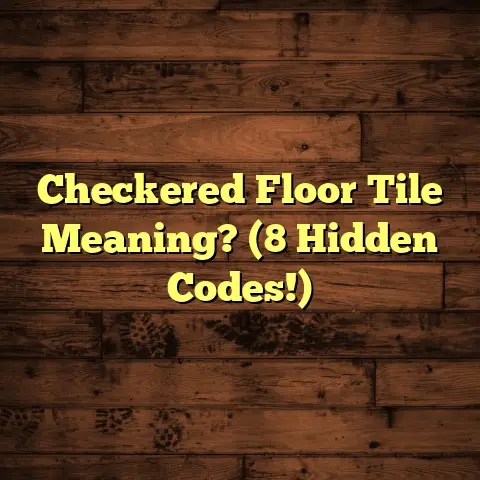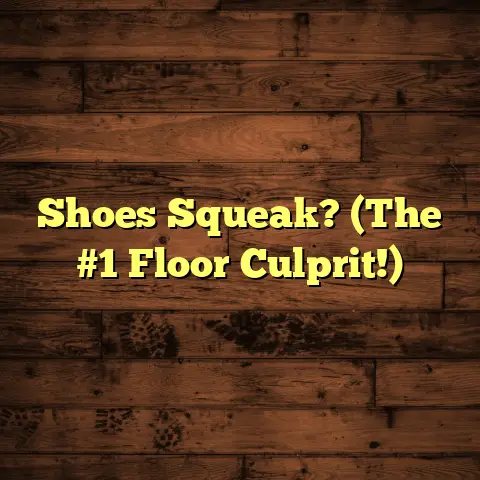Most Soundproof Flooring Options? (3 Quietest!)
Hey everyone, it’s your friendly neighborhood flooring contractor here. Let’s face it: modern life is LOUD.
Whether you’re battling the city’s symphony of sirens or just trying to escape the thundering footsteps of upstairs neighbors, noise pollution is a real issue.
I’ve seen firsthand how disruptive it can be, affecting sleep, focus, and overall well-being.
Imagine this: You finally get home after a grueling day, ready to unwind. But instead of peace and quiet, you’re greeted by a chorus of sounds.
Footsteps echoing from above? A neighbor’s TV blaring through the wall? It’s enough to drive anyone crazy!
That’s why soundproofing your home has become such a priority for so many people. And a big part of that starts with your floors.
In this article, I’m going to walk you through the three quietest flooring options I’ve worked with over the years. These aren’t just random picks; these are the ones that have consistently delivered exceptional results for my clients.
We’ll dive into the nitty-gritty of each option, discussing their benefits, drawbacks, and how to get the most out of their sound-dampening capabilities.
Ready to transform your home into a tranquil oasis? Let’s get started!
Section 1: Understanding
Soundproofing and Flooring
So, what exactly is soundproofing? It’s more than just blocking out noise; it’s about controlling how sound travels within and between spaces.
In a residential setting, soundproofing is all about creating a comfortable and peaceful environment by minimizing unwanted noise.
Think of it as building a sound barrier around your home, preventing external noises from intruding and internal sounds from escaping.
Now, let’s talk about the different types of noise we’re dealing with:
-
Impact Noise: This is the sound created when something strikes a surface, like footsteps, dropped objects, or furniture being moved.
-
Airborne Noise: This travels through the air, like conversations, music, or traffic noise.
Flooring primarily helps with impact noise, but some materials can also dampen airborne sounds.
This is where the Sound Transmission Class (STC) rating comes in. STC is a single-number rating that measures how well a building partition attenuates airborne sound.
The higher the STC rating, the better the material is at blocking sound. For flooring, this rating usually refers to the entire floor-ceiling assembly, including underlayment and any other soundproofing measures.
According to the National Research Council of Canada, a minimum STC rating of 50 is generally recommended for walls and floors between dwelling units to provide reasonable sound isolation.
I’ve found that aiming for an STC rating of 55 or higher can make a noticeable difference in reducing noise transmission.
Section 2: The Role of Flooring in
Soundproofing
Okay, so how does flooring actually impact sound? It’s all about the material’s density, structure, and ability to absorb vibrations.
Hard, dense materials like concrete or tile tend to transmit sound easily, while softer, more resilient materials like carpet or cork absorb sound waves, reducing their transmission.
The way you install your flooring also plays a huge role. A properly installed floor with adequate underlayment can significantly reduce noise transmission compared to a poorly installed floor.
Gaps and voids under the flooring can act as sound amplifiers, so it’s crucial to ensure a tight, secure installation.
And speaking of underlayment, this is where the magic really happens. Underlayment is a layer of material installed between the subfloor and the finished flooring.
It acts as a cushion, absorbing impact noise and preventing it from traveling through the structure of the building.
There are various types of underlayment available, each with different soundproofing properties.
For example, some underlayments are made of recycled rubber, which is excellent at absorbing impact noise. Others are made of foam or cork, which provide additional cushioning and sound insulation.
I always recommend investing in a high-quality underlayment, especially if soundproofing is a priority. It can make a world of difference in the overall noise reduction of your flooring system.
Section 3: The Three Quietest
Soundproof Flooring Options
Alright, let’s get to the good stuff: the three quietest flooring options I’ve worked with. These are the ones that consistently impress me with their sound-dampening abilities.
Option 1: Carpet with Padding
Ah, carpet. It’s a classic for a reason. Not only does it provide warmth and comfort underfoot, but it’s also an excellent sound absorber.
The composition of carpet plays a big role in its soundproofing capabilities. The fibers of the carpet trap sound waves, preventing them from reflecting off the floor and amplifying noise.
The density and thickness of the carpet also affect its sound absorption. A thicker, denser carpet will generally absorb more sound than a thinner, less dense one.
But the real secret to carpet’s soundproofing success is the padding underneath. Carpet padding acts as a cushion, absorbing impact noise and preventing it from traveling through the subfloor.
There are various types of carpet padding available, each with different densities and thicknesses. I recommend choosing a high-density padding made of memory foam or recycled rubber for optimal sound absorption.
When it comes to STC ratings, carpet with padding can achieve impressive results. According to the Carpet and Rug Institute, carpet can improve the STC rating of a floor assembly by as much as 25 points.
In my experience, a good quality carpet with a high-density padding can easily achieve an STC rating of 50 or higher, providing excellent sound insulation.
Beyond soundproofing, carpet also offers a range of other benefits:
-
Warmth: Carpet provides a warm and cozy surface underfoot, making it ideal for bedrooms and living rooms.
-
Comfort: The soft, cushioned surface of carpet is gentle on joints and can reduce fatigue.
-
Safety: Carpet provides a non-slip surface, reducing the risk of falls.
I remember one client in particular, Sarah, who lived in a condo with notoriously thin floors. She was constantly disturbed by the noise from her upstairs neighbors.
After installing a plush carpet with a high-density memory foam padding, she couldn’t believe the difference.
“It’s like night and day,” she told me. “I can finally relax in my own home without being constantly bombarded by noise.”
Option 2: Cork Flooring
Cork flooring is a hidden gem when it comes to soundproofing. It’s a natural, sustainable material that offers excellent sound-dampening properties.
Cork is harvested from the bark of cork oak trees, which regrows every nine years, making it a renewable resource. Its unique cellular structure makes it naturally resilient and sound-absorbent.
Each cubic inch of cork contains millions of tiny air-filled cells, which act as natural sound insulators. These cells absorb sound waves, reducing their transmission through the floor.
The installation process for cork flooring is similar to that of other floating floors. The cork planks or tiles are typically glued or clicked together, creating a seamless surface.
Maintaining cork flooring is relatively easy. Regular sweeping and occasional mopping with a mild detergent are usually sufficient to keep it looking its best.
One of the great things about cork flooring is its eco-friendliness. It’s a sustainable material that’s biodegradable and recyclable.
Plus, cork is naturally resistant to mold and mildew, making it a healthy choice for your home.
Cork also provides excellent thermal insulation, helping to keep your home warm in the winter and cool in the summer.
I’ve seen cork flooring used successfully in a variety of spaces, from bedrooms and living rooms to home offices and studios.
For example, I worked on a project for a musician who wanted to soundproof his home studio.
We installed cork flooring with a thick underlayment, and the results were remarkable. He was able to record music without disturbing his neighbors, and the acoustics in the room were significantly improved.
According to the Cork Quality Council, cork flooring can reduce impact noise by up to 53 dB. In terms of STC ratings, cork flooring can achieve ratings of 50 or higher, depending on the thickness and density of the material.
Option 3: Luxury Vinyl Plank (LVP) with
Acoustic Underlayment
Luxury Vinyl Plank (LVP) has become incredibly popular in recent years, and for good reason. It’s durable, water-resistant, and comes in a wide variety of styles and colors.
But did you know that LVP can also be a great soundproofing option, especially when combined with an acoustic underlayment?
LVP is typically made of multiple layers, including a vinyl core, a decorative layer, and a wear layer. While the vinyl itself doesn’t offer much sound insulation, the addition of an acoustic underlayment can significantly improve its soundproofing capabilities.
Acoustic underlayment is specifically designed to absorb sound and reduce noise transmission. It’s typically made of materials like recycled rubber, foam, or cork.
When choosing an acoustic underlayment for LVP, look for one with a high Impact Insulation Class (IIC) rating. IIC measures how well a flooring system reduces impact noise transmission.
A higher IIC rating indicates better soundproofing performance. I generally recommend aiming for an IIC rating of 70 or higher for optimal noise reduction.
Compared to other hard surface flooring options like hardwood or tile, LVP with acoustic underlayment offers superior soundproofing capabilities.
Hardwood and tile tend to transmit sound easily, while LVP with acoustic underlayment absorbs impact noise and reduces its transmission.
I spoke with an industry professional, Lisa, who specializes in acoustic flooring solutions. She emphasized the importance of choosing the right underlayment for LVP.
“The underlayment is the key to soundproofing with LVP,” she said. “A high-quality acoustic underlayment can make a huge difference in the overall noise reduction of the flooring system.”
She also recommended considering the thickness of the LVP when selecting an underlayment. Thicker LVP planks tend to provide better sound insulation than thinner ones.
According to testing done by certain LVP manufacturers, LVP with acoustic underlayment can achieve STC ratings of 50 or higher, depending on the specific materials used.
Section 4: Additional
Soundproofing Strategies
While flooring is a crucial component of soundproofing, it’s not the only factor to consider. To achieve optimal noise reduction, you may need to implement additional soundproofing strategies.
One effective technique is to treat your walls with sound-absorbing materials like acoustic panels or soundproof curtains. These materials absorb sound waves, preventing them from reflecting off the walls and amplifying noise.
Ceiling modifications can also help reduce noise transmission, especially in multi-story homes. Installing a suspended ceiling with sound-absorbing tiles can significantly dampen airborne noise.
The layout of your room and the placement of furniture can also impact noise levels. Soft furnishings like rugs, sofas, and curtains absorb sound waves, reducing echo and reverberation.
Arranging furniture strategically can also help block sound. For example, placing a bookshelf against a wall can help dampen noise from neighboring rooms.
Section 5: Conclusion
So, there you have it: the three quietest flooring options for soundproofing your home. Carpet with padding, cork flooring, and LVP with acoustic underlayment each offer unique benefits and sound-dampening capabilities.
Choosing the right flooring option is crucial for achieving a peaceful and tranquil living environment. Consider your specific needs and preferences when making your decision.
Do you prioritize warmth and comfort? Carpet might be the best choice for you.
Are you looking for an eco-friendly and sustainable option? Cork flooring could be the perfect fit.
Do you need a durable and water-resistant flooring solution? LVP with acoustic underlayment might be the way to go.
No matter which option you choose, remember that proper installation and the use of high-quality underlayment are essential for maximizing soundproofing performance.
With the right flooring and a few additional soundproofing strategies, you can transform your home into a serene sanctuary where you can relax, focus, and enjoy peace and quiet.





